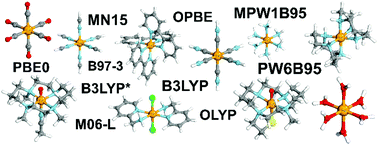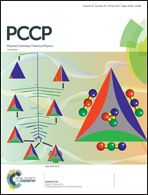Assessment of electronic structure methods for the determination of the ground spin states of Fe(ii), Fe(iii) and Fe(iv) complexes†
Abstract
Our ability to understand and simulate the reactions catalyzed by iron depends strongly on our ability to predict the relative energetics of spin states. In this work, we studied the electronic structures of Fe2+ ion, gaseous FeO and 14 iron complexes using Kohn–Sham density functional theory with particular focus on determining the ground spin state of these species as well as the magnitudes of relevant spin-state energy splittings. The 14 iron complexes investigated in this work have hexacoordinate geometries of which seven are Fe(II), five are Fe(III) and two are Fe(IV) complexes. These are calculated using 20 exchange–correlation functionals. In particular, we use a local spin density approximation (LSDA) – GVWN5, four generalized gradient approximations (GGAs) – BLYP, PBE, OPBE and OLYP, two non-separable gradient approximations (NGAs) – GAM and N12, two meta-GGAs – M06-L and M11-L, a meta-NGA – MN15-L, five hybrid GGAs – B3LYP, B3LYP*, PBE0, B97-3 and SOGGA11-X, four hybrid meta-GGAs – M06, PW6B95, MPW1B95 and M08-SO and a hybrid meta-NGA – MN15. The density functional results are compared to reference data, which include experimental results as well as the results of diffusion Monte Carlo (DMC) calculations and ligand field theory estimates from the literature. For the Fe2+ ion, all functionals except M11-L correctly predict the ground spin state to be quintet. However, quantitatively, most of the functionals are not close to the experimentally determined spin-state splitting energies. For FeO all functionals predict quintet to be the ground spin state. For the 14 iron complexes, the hybrid functionals B3LYP, MPW1B95 and MN15 correctly predict the ground spin state of 13 out of 14 complexes and PW6B95 gets all the 14 complexes right. The local functionals, OPBE, OLYP and M06-L, predict the correct ground spin state for 12 out of 14 complexes. Two of the tested functionals are not recommended to be used for this type of study, in particular M08-SO and M11-L, because M08-SO systematically overstabilizes the high spin state, and M11-L systematically overstabilizes the low spin state.



 Please wait while we load your content...
Please wait while we load your content...